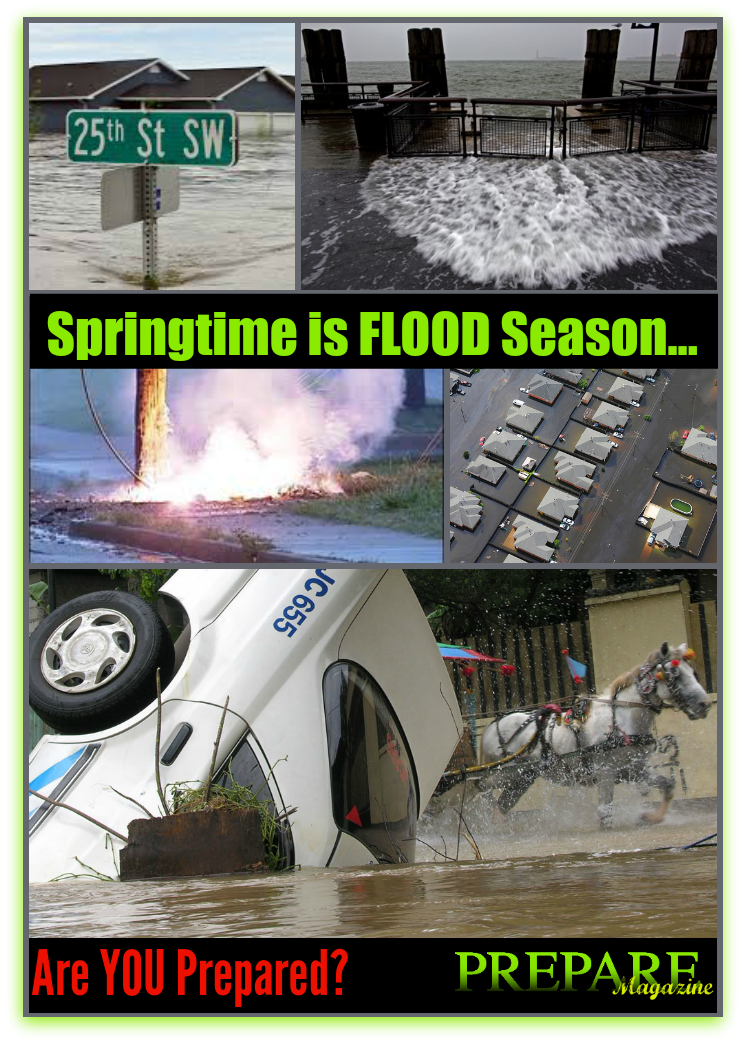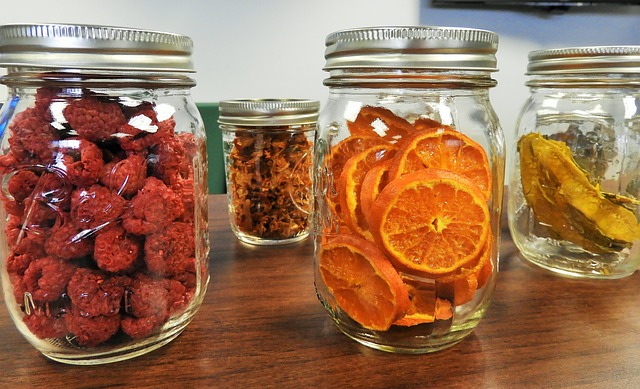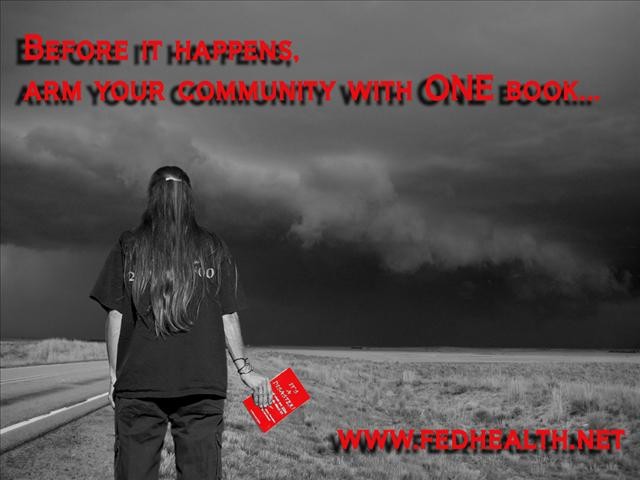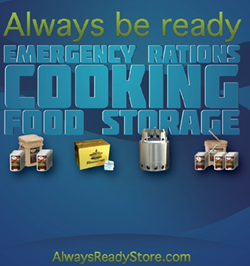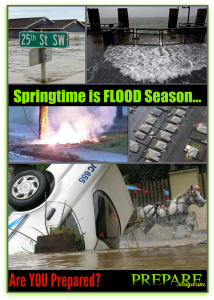 Severe Spring Weather Week is something that rolls around each year. You may or may not have been aware that this focus existed, but many regional branches of Homeland Security focus on the natural disasters that often affect their area in the spring.
Severe Spring Weather Week is something that rolls around each year. You may or may not have been aware that this focus existed, but many regional branches of Homeland Security focus on the natural disasters that often affect their area in the spring.
We will be taking one typical Spring Severe Weather occurrence per day and focusing on it in hopes of keeping you safe. Please join us on our Facebook Page to read even more articles and share them with friends who may live in areas that are prone to the disastrous effects of Spring Severe Weather.
Today’s topic is Flooding.
One reason that Spring traditionally brings the heightened potential for flooding is that the ground in many areas is already saturated from the melting snows. The melted snow makes the ground less absorbent, because it is already ‘full’, much like a sponge.
Very dry ground is also quite susceptible to flooding. In areas that may not have received snow, the melting ice and snow from higher elevations and upcoming spring rains and thunderstorms cause run-off and flooding where the ground may have been too dry and thus the surface is too hard to absorb the water.
We want to hear from YOU… so please leave a comment and connect with us on Facebook .
Below is an excellent post written by one of the regular writers for PREPARE Magazine. We hope that his information is found timely and informative for you to keep you and your loved ones aware and prepared.
[wpgfxm_contentbox width=”50%” bg_color=”#F1F8FB” b_color=”#D94A2E” style=”double” top=”1px” right=”none” bottom=”1px” left=”none” radius=”0px”]FREE Digital Subscription to PREPARE Magazine[/wpgfxm_contentbox]
Flood Safety
by Joe Alton, M.D., aka Dr. Bones
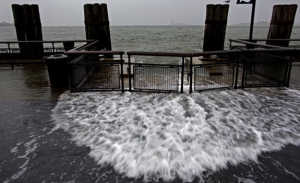 We frequently discuss the risks associated with storms such as hurricanes and tornadoes, but not as much about the complications that occur as a result. Just about any storm can cause a deluge of water, and this can cause a deluge in the biblical sense. Last year in Boulder, Colorado, it happened when 6 months of rain fell during a week’s time. As such, it’s important to know flood safety precautions.
We frequently discuss the risks associated with storms such as hurricanes and tornadoes, but not as much about the complications that occur as a result. Just about any storm can cause a deluge of water, and this can cause a deluge in the biblical sense. Last year in Boulder, Colorado, it happened when 6 months of rain fell during a week’s time. As such, it’s important to know flood safety precautions.
What is a Flood?
The definition of a flood is an overflow of water that submerges land which is normally dry. Flooding may occur as an overflow of water from water bodies (such as a seacoast, river or lake) in which the water runs over or breaks levees, resulting in the escape of large amounts of water into populated areas. It may also occur due to an accumulation of rainwater on saturated ground.
Some floods develop slowly, while others (called flash floods), can develop in a very short time and affect areas where it wasn’t even raining. As a result, it often catches the population downriver by surprise, causing severe damage and loss of life
FLOOD TYPES
There are several types of floods:
Areal Floods
Floods can happen on flat or low-lying areas when the ground is saturated and water cannot run off quickly enough to stop accumulating. This may be followed by a river flood as water moves into local waterways. Floods related to rainfall can also occur if water falls on an impenetrable surface, such as concrete, asphalt paving or frozen ground, and cannot rapidly be absorbed into the ground. In urban areas, it usually takes at least 1 inch (25 mm) of rainfall per hour to start significant ponding of water on impermeable surfaces.
Riverine Floods
Floods happen in rivers when the flow rate exceeds the capacity of the river channel, particularly at bends in the waterway. These are some of the most dangerous, as people tend to live and work by rivers due to access to fertile soil, irrigation, and trade routes.
River flows may rise to flood levels at different rates, from a few minutes to several weeks, depending on channel width and the source of the increased flow.
Slow rising floods most commonly occur in large rivers, like the Mississippi, that have large catchment areas. The increase in flow may be the result of sustained rainfall, rapid snow melt, monsoons, or tropical storms.
Coastal Floods
Flooding on the coast is commonly caused by a combination of sea tidal surges caused by winds and low barometric pressure. Coastal areas may be flooded by storm events, such as hurricanes, resulting in waves over-topping seawalls and levees.
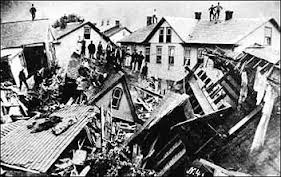 (left) Aftermath of dam collapse in Johnstown, PA 1889
(left) Aftermath of dam collapse in Johnstown, PA 1889
Failures of infrastructure such as the collapse of a dam may cause catastrophic flooding, as in the Johnstown, Pennsylvania event in 1889 that took 2,200 lives. Major flooding may also be caused by the effects of an earthquake or volcanic eruption. These events often occur at sea, hundreds of miles from the area affected, but result in tidal wave floods called Tsunamis. The penetration of salt water causes widespread failure of fresh water delivery systems and may make farmland unusable, sometimes for many years.
Flooding often causes a failure of the power grid. Once this happens, the aftermath of the disaster may have more severe effects than the flood itself. These effects include loss of the water supply due to contamination by sewage. As a result, water-borne illness such as diarrheal disease may take a major toll on the population. Cholera and Typhoid are just some of the diarrheal/dysenteric diseases which may be life-threatening. Other issues include the inability of aid to get to flooded areas and the inundation of farmland causing loss of entire crops. Some industries may fail, leading to depression in the affected area. Once water and food shortage combine with the inability to receive help and/or make a living, economic collapse and civil unrest are likely to follow.
The scenario above is not purely hypothetical: Disasters related to flooding have sometimes caused millions of short- and long-term casualties. In both 1887 and 1931, major flooding of the Yangtze river in China ended up costing 1-2 and 3-4 million lives, respectively. If you take out war, famine, and pandemics, flooding is, undeniably, the deadliest of human tragedies.
Most people have heard of hurricane or tornado watches and warnings, but the U.S. weather services also tries to warn the populace of flooding. A “flash flood watch” means that flash flooding is possible in the near future; a “flash flood warning” means that flooding is imminent in the area. Many people ignore these warnings at their own peril.
If you live in a low-lying area, especially near a dam or river, then you should heed warnings when they are given and be prepared to evacuate quickly. Rising flood waters could easily trap you in your home, and you don’t want to have to perch on your roof waiting for help.
[wpgfxm_contentbox width=”50%” bg_color=”#F1F8FB” b_color=”#D94A2E” style=”double” top=”1px” right=”none” bottom=”1px” left=”none” radius=”0px”]FREE Digital Subscription to PREPARE Magazine[/wpgfxm_contentbox]
FLOOD SAFETY TIPS
Get Out Early
Make the decision to leave for higher ground before extensive ponding occurs.
Be Careful Walking Through Flowing Water
Drowning is the most common cause of death during a flood, especially a flash flood. Wilderness experts know that rapidly-moving water can knock you off your feet even if not that deep.
Don’t Drive Through a Flooded Area
As many people drown in their cars as anywhere else. Cars stall and roads/bridges could easily be washed out. Try to figure out now if there is a “high road” to safety, before a flood occurs.
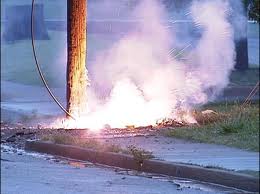 Beware Of Downed Power Lines
Beware Of Downed Power Lines
Electrical current is easily conducted through water. Watch for downed power lines; you don’t have to touch them to be electrocuted, only step in the water they’re in.
Turn Off The Power
If you have reason to believe that water will get into your home, turn off the electricity. Don’t use appliances or motors that have gotten wet unless they have completely dried. You might have to take some apart to clean debris out of them.
Watch Out For Intruders
Critters that have been flooded out of their homes may seek shelter in yours. Snakes, raccoons, and other unfriendly creatures may decide your home is now their territory. Human
intruders may also be interested in your property.
Look Before You Step
After a flood, watch where you step; there is debris everywhere. The floors of your home may be covered in mud, causing a slip-and-fall hazard.
Check for Gas Leaks
Don’t use candles, lanterns, stoves, or lighters unless you are sure that the gas has been turned off and the area has been well-ventilated.
Exhaust Fumes Can Kill!
Only use generators, camping stoves or charcoal grills outside. Their fumes can be deadly.
Clean Out Saturated Items Completely
Floodwaters are not clean! Don’t use floodwater as drinking water or to cook food unless you have thoroughly sterilized and filtered it. Make sure you have food storage in waterproof containers.
Floods are just one of the many natural disasters that can endanger your family. Pay close attention to storm and flood warnings and you’ll have a head start on keeping them safe.
[wpgfxm_contentbox width=”50%” bg_color=”#F1F8FB” b_color=”#D94A2E” style=”double” top=”1px” right=”none” bottom=”1px” left=”none” radius=”0px”]FREE Digital Subscription to PREPARE Magazine[/wpgfxm_contentbox]
For more tips on Health & Medical Safety and Preparedness please visit Dr. Alton’s Website mentioned in his bio below. For more encouragement to a lifestyle of Preparedness and articles that span a variety of topics subscribe to the free digital issues of PREPARE Magazine.
Look for more topics about Spring Severe Weather Natural Disasters. Please share this post with friends. Let’s help keep everyone aware and prepared!
___________________________
 Joe Alton, M.D. (aka: Dr. Bones) is a member of Mensa, collects 19th-century medical books to gain insight on off-grid medical strategies. He is the co-author, along with Amy Alton, A.R.N.P. (aka Nurse Amy), of the #1 Amazon Bestseller in Survival Skills “The Survival Medicine Handbook“. The opinions voiced by Dr. Bones and Nurse Amy are for post-apocalyptic settings only; in normal times, seek modern and standard medical care from qualified professionals.
Joe Alton, M.D. (aka: Dr. Bones) is a member of Mensa, collects 19th-century medical books to gain insight on off-grid medical strategies. He is the co-author, along with Amy Alton, A.R.N.P. (aka Nurse Amy), of the #1 Amazon Bestseller in Survival Skills “The Survival Medicine Handbook“. The opinions voiced by Dr. Bones and Nurse Amy are for post-apocalyptic settings only; in normal times, seek modern and standard medical care from qualified professionals.

